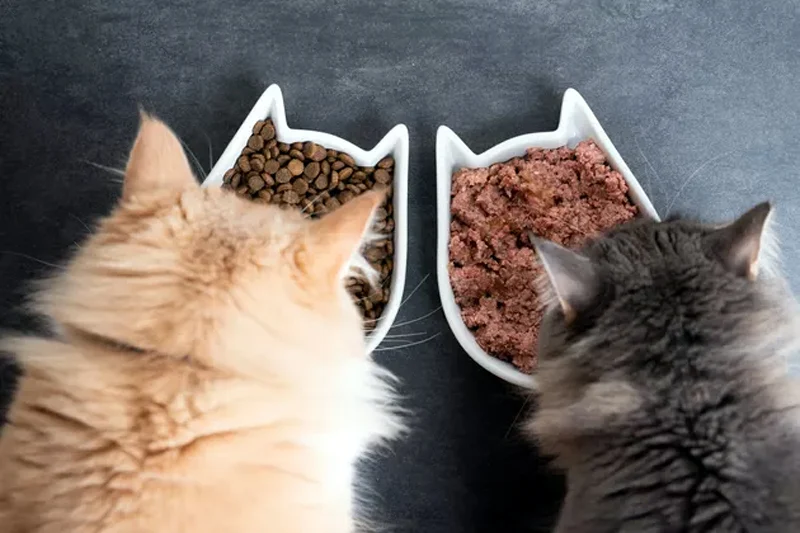![[feature] How To Read Pet Food Labels](https://blogger.googleusercontent.com/img/b/R29vZ2xl/AVvXsEhUKN5DdNrOsp1M7jqOY0xVpelX1HqmGx-bwy4GOl-rikS-K-bOSJFD_5r1zdHTywuc_OGpGsXofJG9viT9DF-dLFAMjRhG0MWmaGv6kjerEd3iKrD3HWd4X6I6qWF3GLkMPWPl-FjocMOD/s16000-rw/cake.jpg) |
| © anastas_/iStock/GettyImages |
By Vanessa Salvia ,Cuteness
Ever find yourself standing in the pet food aisle and wondering just what the difference is between all the different brands and food types?
Whether you're at the grocery store, pet specialty store, or even at the vet's office, it's easy for all the brands and labels to seem the same. Here are some tips on how to interpret pet food labels and be sure you're buying the right kind of food for your pet, and getting what you think you are getting.
Standards of pet food regulation
First of all, this is a complicated topic as you might imagine. The labels and ingredients in pet foods are regulated by two groups: the federal Food and Drug Administration (FDA) and the state-level Association of American Feed Control Officials (AAFCO). The FDA establishes standards for all animal feeds that includes proper listing of ingredients and statements on quantities. Many states also enforce their own labeling regulations.Read the ingredient list
The Food and Drug Administration explains that if a pet food is labeled as something like "Chicken for Cats," at least 95% if the ingredients must be that item: chicken. It should be the first ingredient listed on the label. If the name is "lobster and caviar" food for pets, then the two named ingredients together must comprise 95 percent of the total weight. The first ingredient (lobster) named in the product name must be the one with the highest proportion in the ingredient list (lobster should come before caviar in the ingredients, in this example). Always check the label to see what else you are buying, because even a "chicken" cat or dog food can contain other ingredients such as fish. |
| © Eva Blanco / EyeEm/EyeEm/GettyImages |
A food with a name that includes "dinner" or "platter" has different proportions. In those, the combination of the named ingredients must total 25 percent of the product and be listed in the same order on the ingredient list. Also, each named ingredient must be at least 3 percent of the total. "Lobster n' Caviar Platter For Cats" must have 25 lobster and caviar combined, and at least 3 percent caviar.
Many labels often say things like "crude protein," fat, or fiber. This term is an old-fashioned measure of how the nutrient was tested, explains the AAFCO. For example, crude protein is determined by analyzing the amount of nitrogen in a sample of the product then multiplying by 6.25. It has no bearing on how much nutrient potential is actually in the protein, fat, or fiber. Some experts say this method of measurement can be used to artificially inflate the amount of the nutrient that is actually in the sample.
Guaranteed analysis and maximum percentages
The AKC explains that guaranteed analysis specifies the amount of specific nutrients in a food. A pet food must have certain minimum amounts of nutrients. This means the label must explicitly state the amount of crude protein, crude fat, crude fiber, and water in a food. In some cases, both a minimum and maximum percentages of nutrients must be guaranteed. If a product claims to have vitamin or mineral supplements, there must be a guarantee of the amount the product supplies.The FDA explains further that when comparing canned foods, note that under AAFCO regulations, the maximum moisture content for a pet food is 78 percent. Products labeled as "stew," "in sauce," or "in gravy" can contain as much as 87.5 percent moisture. This means that their dry contents are considerably less, in order to account for the moisture increase. The FDA says a product with a guarantee of 87.5 percent moisture contains 12.5 percent dry matter, only half as much as a product with a 75 percent moisture guarantee (25 percent dry matter). This can make a difference in the overall nutrients your cat or dog is getting.
Calorie content nutrition guarantees
Dogs and cats require omega-6 and omega-3 fatty acids in the diet because they cannot produce these essential fatty acids on their own. Many foods add these nutrients, in the form of DHA, or docosahexaenoic acid, and EPA, or eicosapentaenoic acid. Sometimes, these fatty acids are in the form of fish oil. Today's Veterinary Practice journal cautions against supplementing with fatty acids without discussing a full health history with your animal's vet. This is because supplementing with omega-6 or omega-3 fatty acids can have adverse effects, particularly if the patient is already overweight (because fatty acids add fat to the diet) or has other adverse medical conditions. |
| © Nils Jacobi/iStock/GettyImages |
Many pet foods claim to be "complete and balanced" or "100 percent nutritious." This can lead people to think that food is all their pet needs. If a pet food says this, it must meet specific government standards. These foods will have a Nutritional Adequacy Statement," often in small print on the back or side of the package. These statements are in 3 recognized formats that give information about the life stages the nutrition is optimized for and whether it's for a dog or cat.
The AAFCO recognizes these life stages:
- Gestation/lactation (pregnancy and post-pregnancy)
- Growth (young life)
- Maintenance (adulthood)
- All life stages
If you're comparing nutrition between dry food and canned food, the FDA reports that the amount of dry matter in dry food is about four times the amount in a canned food. To compare guarantees between a dry and canned food, multiply the guarantees for the canned food times four first.
See more at Cuteness
























